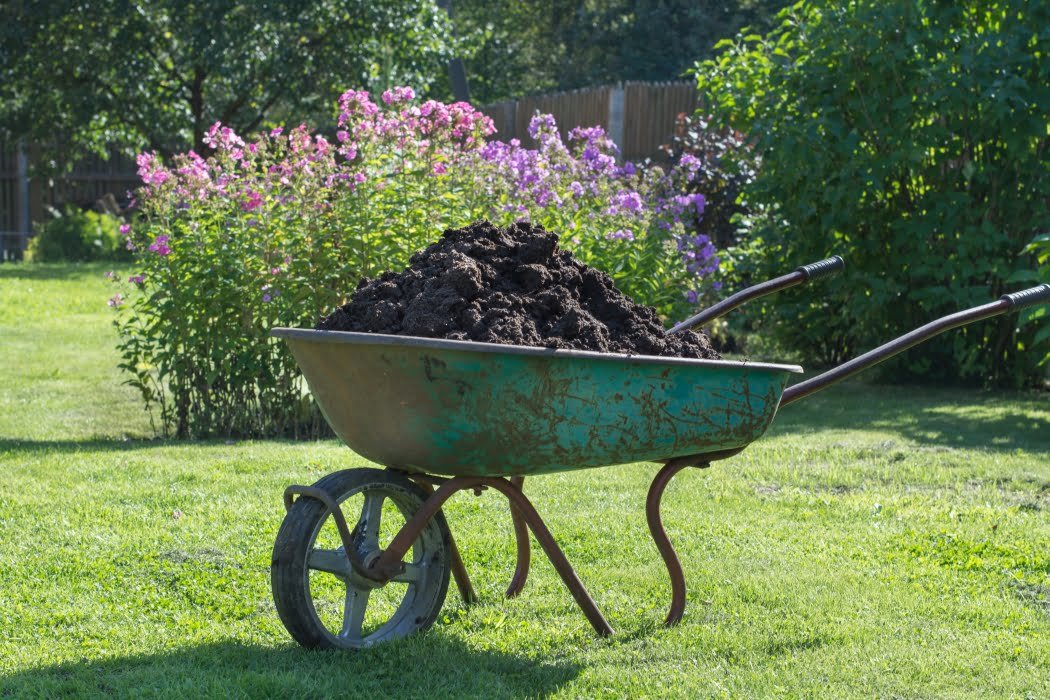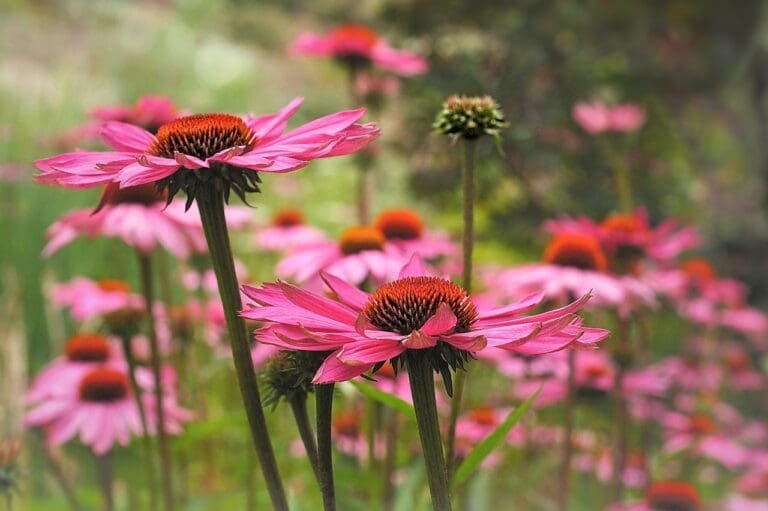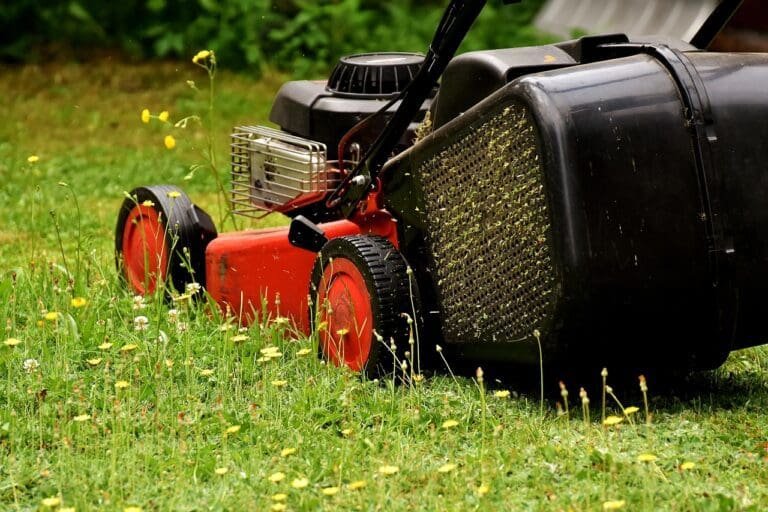Applying organic mulch to your garden beds is a simple yet highly effective way to boost the health and appearance of your garden. Organic mulch, which can be made from compost, wood chips, bark, and other organic materials, serves as a protective layer for your garden beds. This addition is not just about aesthetics; it brings a host of benefits to your garden’s ecosystem.
In this article, we’ll delve into the various types of garden mulch available and discuss the specific benefits each type offers. Whether you’re a seasoned gardener or just starting out, understanding how to effectively use mulch can make a significant difference in your garden’s vitality.
You might also be interested in: Reduce Weeds in Your Garden Without Using Chemicals
| Type of Mulch | Description | Benefits | Drawbacks |
|---|---|---|---|
| Bark Chippings | A common organic mulch choice, offering an aesthetic finish and effective weed suppression. Slow decomposition rate makes it durable. | Insulates soil and plants, reduces replenishment frequency, widely available. | May not add as many nutrients to the soil compared to other organic mulches. |
| Compost | Rich in nutrients, compost mulch enhances plant growth and provides insulation. It improves the appearance of garden beds and adds contrast. | Enhances soil quality, boosts plant health. | Decomposes swiftly, requiring frequent replenishment. |
| Leaf Mould | Created by collecting and bagging fallen leaves for about a year. It’s a cost-effective and eco-friendly option. | Naturally enhances soil quality over time, nutrient-rich. | Takes a long time to prepare and may not be as nutrient-rich as other options. |
| Organic Mulch Blends | Blends often combine compost and bark, designed to thwart weeds. Some blends offer extended weed prevention. | Aesthetic appeal, multiple garden benefits, time-saving in weeding. | May not be as effective as pure forms in specific functions (e.g., nutrient provision, weed control). |
| Cardboard | A repurposed packaging material, excellent for suppressing weeds and preparing new garden beds. | Good for weed suppression, but does not contribute nutrients to the soil. | Does not add nutrients to the soil, may be less aesthetically pleasing. |
| Grass Clippings | Easily accessible, decompose quickly, and are rich in nitrogen. Ideal for vegetable gardens. | Effective for recycling lawn waste, especially in vegetable gardens. | May contain weed seeds or chemicals from lawn treatments, less suitable for flower gardens. |
| Gravel | An inorganic mulch, available in various colours, providing a long-lasting solution. | Effective at curbing weed growth, low maintenance, decorative. | Does not improve soil quality, can be difficult to remove or change later. |
| Slate | A durable mulching option, proficient in suppressing weeds and reducing watering needs. Available in various colours. | Long-lasting, weather-resistant. | Sharp edges can be hazardous, may trap debris in crevices, requiring extra maintenance. |
Advantages of Applying Organic Mulch to Your Garden
- Enhances the structure of the soil
- Aids in retaining soil moisture
- Suppresses weed growth
- Adds an attractive finish to the garden
- Boosts soil drainage
- Improves overall plant health
Types of Organic Garden Mulch
1. Bark chippings

Bark chippings are a popular choice for organic mulch, bringing a blend of practicality and aesthetic appeal to garden beds. Their natural look not only enhances the beauty of your garden but also serves a functional purpose in weed suppression. The chippings create a barrier that makes it difficult for weeds to penetrate and grow.
One of the standout features of bark chippings is their slow decomposition rate, especially when compared to compost. This quality makes them a long-lasting mulch option, meaning you won’t need to replenish them as often. It’s a time-saving and cost-effective solution for busy gardeners.
In addition to weed control, bark chippings provide valuable insulation for soil and plants during the colder months. They act as a protective layer, shielding your garden from extreme temperature fluctuations. This insulation is crucial for maintaining healthy plant roots and soil structure.
Easy to spread and readily available at most local garden centres, bark chippings are a convenient choice for gardeners of all levels. They offer a practical, visually pleasing, and long-lasting mulching solution for enhancing and protecting garden beds.
2. Compost
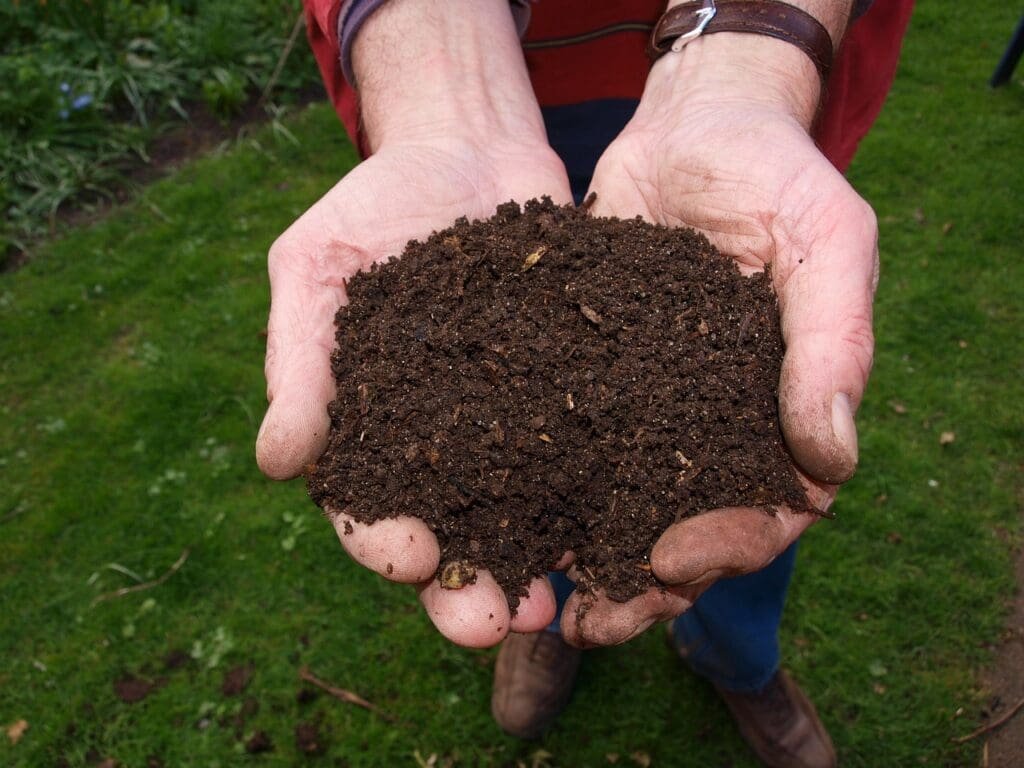
Compost mulch is a fantastic way to enrich your garden’s soil health. Loaded with essential nutrients, it not only promotes vigorous plant growth but also provides valuable insulation during the colder months. This makes it an excellent choice for gardeners looking to maintain a healthy and vibrant garden year-round.
One of the immediate benefits of using compost as mulch is the visual enhancement it brings to garden beds. It quickly improves the appearance of the soil, adding a rich, dark contrast that makes the colours of your plants pop. This aesthetic improvement is a simple yet effective way to elevate the overall look of your garden.
While compost is highly beneficial, it’s important to note that it decomposes faster than other types of mulch. This means you’ll need to replenish it more regularly to maintain its positive effects on soil quality. Despite this, compost remains an effective and attractive option for boosting both the health and aesthetic appeal of your garden.
3. Leaf mold
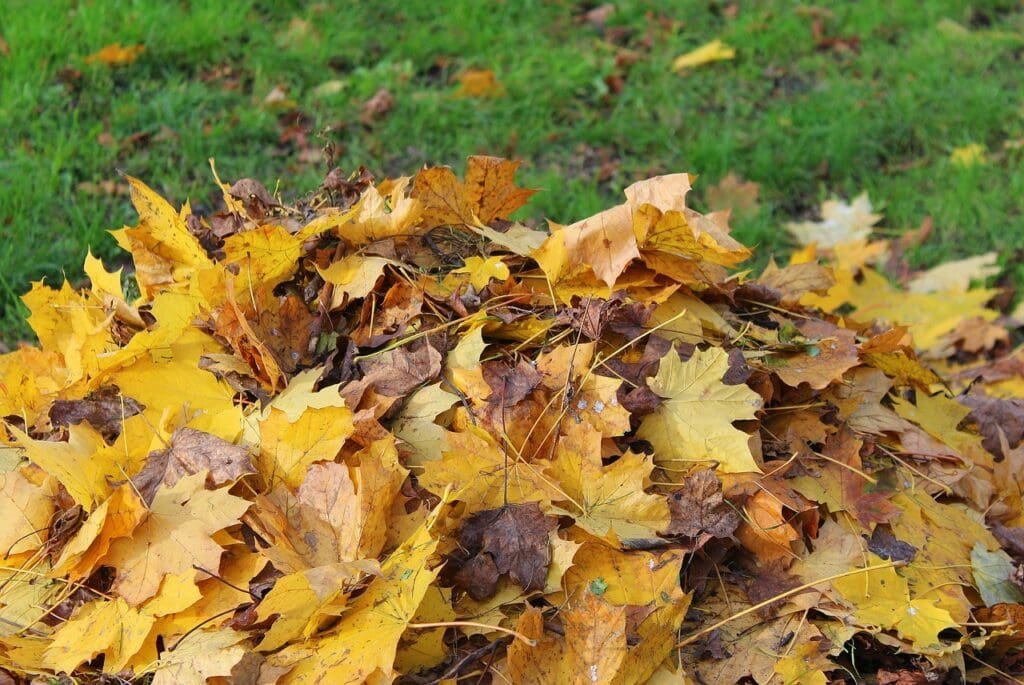
Leaf mold is an outstanding organic mulch choice, known for its natural ability to enhance soil quality with each application over time. The process of creating leaf mold is straightforward and environmentally friendly. Simply gather fallen leaves, bag them, and let them decompose for about a year. This method transforms the leaves into a nutrient-rich mulch that significantly boosts plant health.
Not only is using leaf mold as mulch beneficial for your garden, but it’s also cost-effective. By repurposing natural materials that are readily available, you can create a high-quality mulch without any additional expense. This approach is a great example of sustainable gardening, utilizing what nature provides to improve your garden’s health and vitality.
4. Organic Mulch Blends
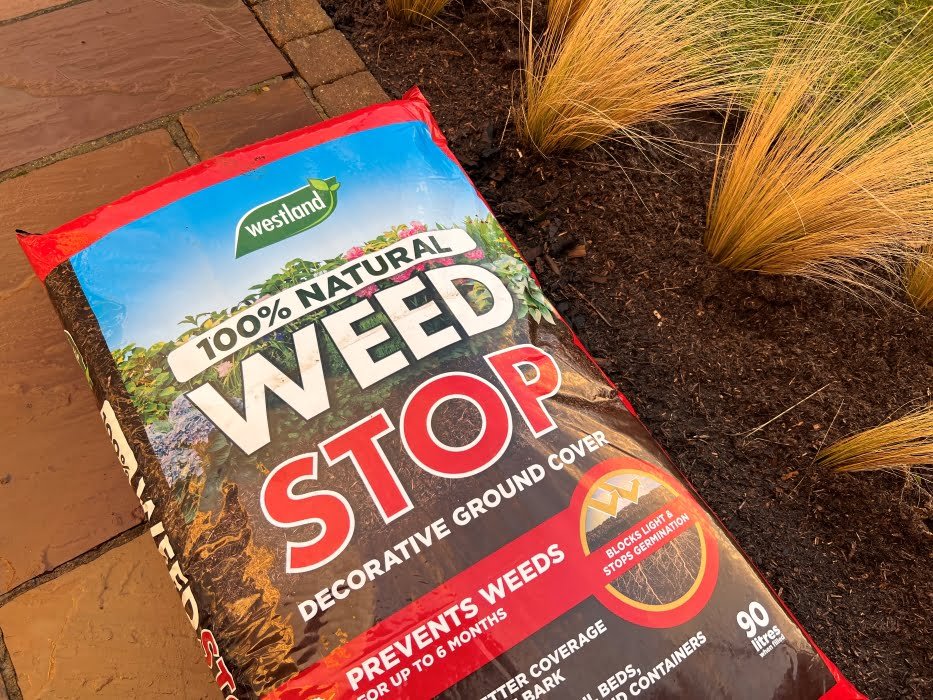
Many garden centres now offer specialized organic mulch blends that are specifically formulated to combat weeds. These blends typically combine the best of both worlds – the nutrient-rich properties of compost and the long-lasting, aesthetic benefits of bark. This results in a mulch that not only looks good but also provides multiple advantages for your garden.
Products like ‘Weed Stop’ by Westland are designed with weed prevention in mind, offering protection for up to six months. Using these mulch blends can significantly reduce the time and effort you spend on weeding. This means more time to enjoy the beauty and tranquility of your garden. It’s a practical solution for gardeners looking to maintain their gardens with less labour and more pleasure.
5. Cardboard
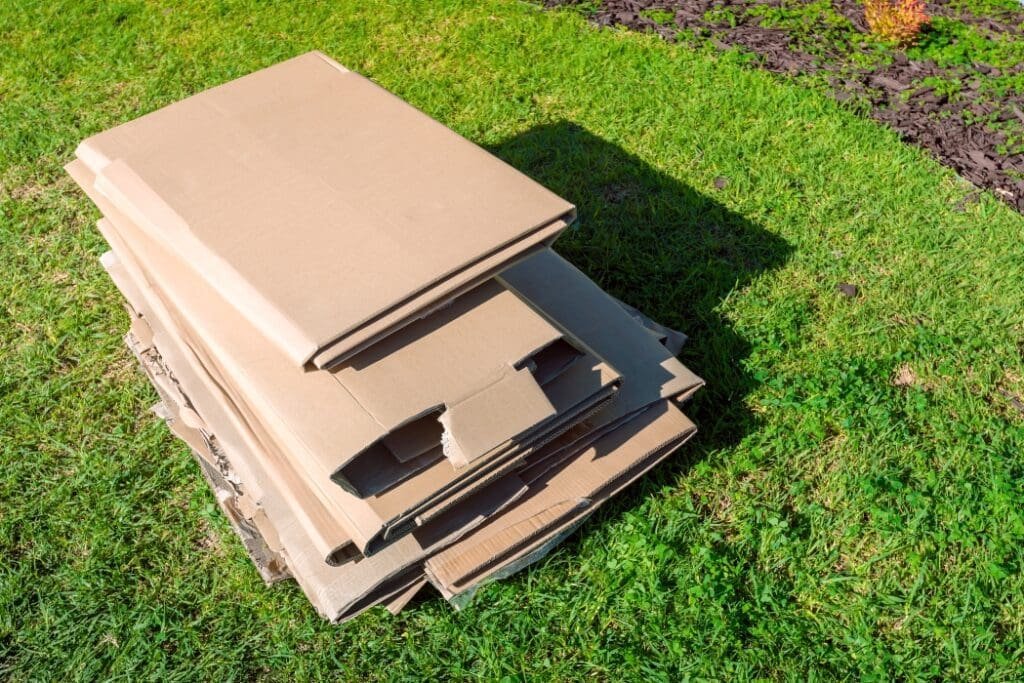
Cardboard, often abundant as a packaging material, can be ingeniously repurposed in the garden. It’s particularly effective for suppressing weeds and preparing new garden beds. When using cardboard in your garden, it’s important to lay it out carefully and ensure it’s adequately weighed down to stay in place.
However, be cautious with the type of cardboard you use. It’s best to avoid heavily printed or dyed cardboard, as the inks may leach into the soil and potentially harm your garden’s ecosystem. Plain, unprinted cardboard is the safest choice.
While cardboard is a fantastic tool for weed suppression and bed preparation, it’s worth noting that it doesn’t add nutrients to the soil like other organic mulches do. Therefore, it’s often used in combination with other mulching materials to provide both weed control and soil enrichment.
6. Grass Clippings
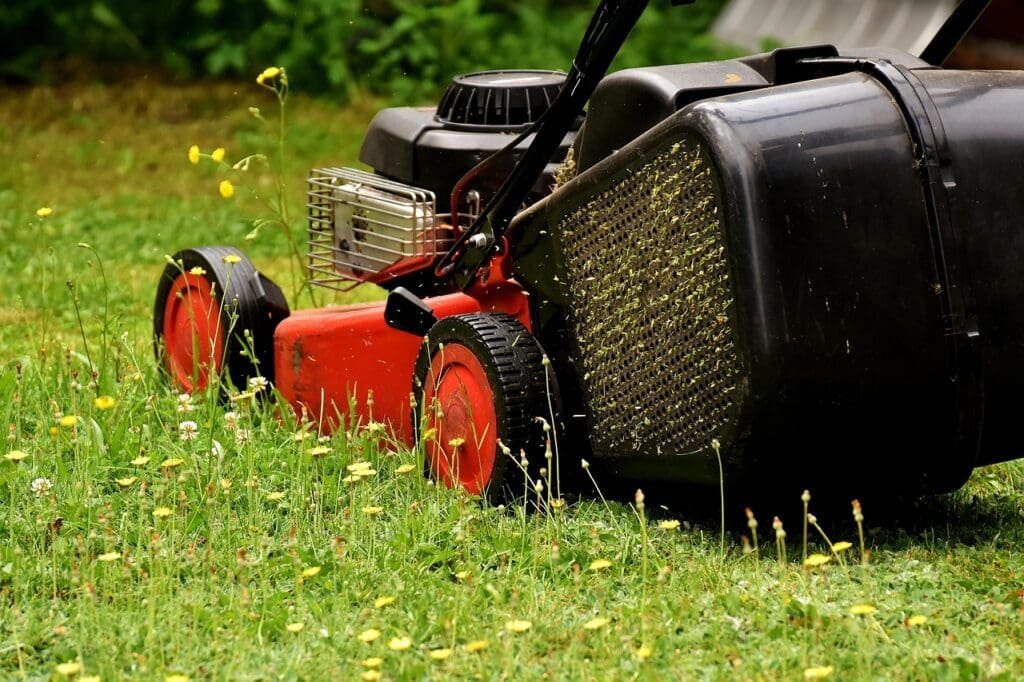
Grass clippings are perhaps the most readily available form of mulch for many gardeners. These clippings break down quickly and are naturally high in nitrogen, which makes them particularly beneficial for vegetable gardens.
However, it’s important to be mindful of their potential downsides. Grass clippings might contain weed seeds or remnants of lawn grass that could sprout in your garden beds. This makes them less ideal for use in flower gardens where unwanted growth could be an issue. Additionally, if your lawn has been recently treated with weed killers or other chemicals, it’s best to avoid using these clippings as they could harm your plants.
For gardeners interested in recycling and making the most of their lawn waste, grass clippings can be an excellent choice, especially in vegetable gardens where their rapid decomposition and nutrient content can support healthy plant growth.
Types of Inorganic Mulch
7. Gravel
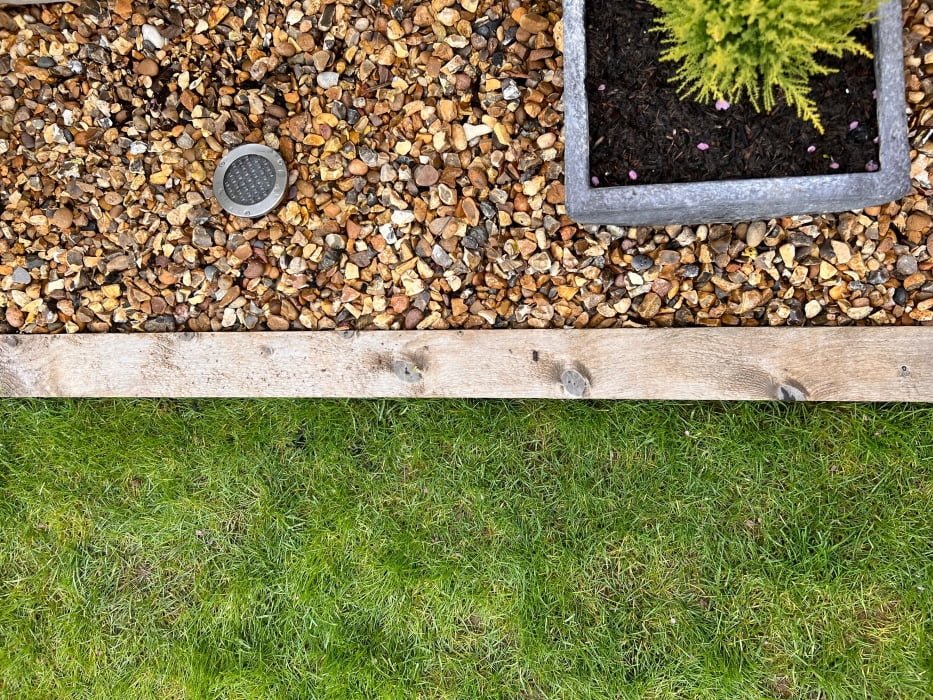
Gravel is a widely favoured inorganic mulch option, known for its durability and variety of colours. It offers a more permanent solution compared to organic mulches, making it a popular choice for gardeners seeking a low-maintenance approach.
While gravel is excellent at suppressing weed growth, it’s important to note that it doesn’t contribute to soil enrichment like organic mulches. However, its decorative appeal can significantly enhance the aesthetic of garden beds and landscapes.
If you’re looking for a mulching option that combines practicality with visual appeal and requires minimal upkeep, gravel could be an ideal choice. It’s particularly suited for areas where long-lasting ground cover and a neat, tidy appearance are desired.
8. Slate
Slate is an excellent choice for mulching, known for its effectiveness in weed suppression and reducing the need for frequent watering. Its variety of colour options allows you to easily find a style that complements your garden’s aesthetic.
One of the key advantages of slate is its durability and ability to withstand harsh weather conditions, making it a long-lasting mulching solution. However, it’s important to handle slate with care due to its sharp edges, especially when spreading it around plants.
When choosing slate pieces, consider the size. Larger pieces can create crevices that may trap leaves and debris, potentially requiring additional maintenance over time. Despite this, slate remains a popular choice for gardeners looking for a mulch that offers both practical benefits and visual appeal.
Organic vs Inorganic Mulch
Both organic and inorganic mulches offer distinct advantages and some drawbacks, making them suitable for different gardening needs.
Organic Mulches:
- Organic options like compost or bark are excellent for improving soil quality over time. As they decompose, they enrich the soil with nutrients, enhancing its structure and drainage. These types of mulch are generally more affordable but do require regular replenishment. When applied annually, organic mulch continues to contribute positively to soil health.
Inorganic Mulches:
- Inorganic mulches, such as gravel or slate, stand out for their durability and effectiveness in weed suppression. While they tend to be more expensive upfront, they offer a long-term solution that doesn’t need frequent replacement. However, unlike organic mulches, they don’t enhance soil fertility. For gardeners focused on long-lasting weed control and a more permanent landscape solution, inorganic mulches are a compelling choice.
Each type of mulch serves a specific purpose in the garden, whether it’s enriching the soil or providing a low-maintenance, decorative ground cover. Understanding these differences can help you choose the right mulch to meet your gardening goals.
How to Apply Organic Mulch

Before you start mulching your garden beds with organic materials, some groundwork is necessary. Here’s how to prepare and apply organic mulch effectively:
- Clear the Area: Start by removing any weeds or grass from the area where you plan to apply the mulch. This step is crucial to prevent these unwanted plants from growing through the mulch layer later on.
- Even Out the Soil: Once the area is cleared, use a rake to smooth and level the soil. This ensures a uniform application of the mulch and helps it to function effectively.
- Apply the Mulch Generously: When it comes to laying down the mulch, don’t be shy. Aim for a layer that’s about 2-3 inches thick. This depth is ideal for suppressing weed growth and helping the soil retain moisture, which is vital for the health of your plants.
A thick layer of organic mulch can transform your garden beds, not only enhancing their appearance but also creating a more conducive environment for plant growth. Remember, a little effort in preparation and application can yield significant benefits for your garden.
Top Tip – Avoid placing mulch too close to the stems of young plants, as this can cause rot and hinder growth; always leave a small gap to allow for proper air circulation.
How to Apply Inorganic Mulch
When it comes to laying inorganic mulch in your garden, the process involves a few straightforward steps:
- Level the Soil: Begin by using a rake to smooth out the soil surface. This ensures an even base for the mulch. While it’s often recommended to remove weeds first, this step may not be necessary unless the area is heavily overgrown.
- Lay Landscape Fabric: Once the soil is leveled, place a permeable landscape fabric over the area. This fabric acts as a barrier to help prevent weed growth. Secure it in place using weights or garden pins to keep it from shifting.
- Add Inorganic Mulch: Now, spread your chosen inorganic mulch – be it gravel, pebbles, slate, or another material – over the landscape fabric. The thickness of the mulch layer can vary based on your preference and the type of material used. This layer will not only enhance the aesthetic appeal of your garden but also provide a durable, low-maintenance ground cover.
Using landscape fabric under inorganic mulch is a smart strategy to maintain a neat and weed-free garden. This combination offers an attractive and permanent solution that complements your garden’s design while minimizing upkeep.
Final thoughts
In conclusion, using organic mulch in your garden offers numerous advantages, including improved soil quality, enhanced moisture retention, effective weed suppression, and a visually appealing finish. When selecting a mulch, it’s important to consider both your garden’s specific needs and your personal preferences.
For those focused on enriching soil health, organic options like compost or bark are ideal. These mulches gradually break down, adding nutrients to the soil and improving its structure. On the other hand, gardeners looking for a more durable, low-maintenance solution might lean towards inorganic mulches such as gravel or stones. These can be used alone or in combination with landscape fabric for added weed control.
Choosing the right mulch can significantly impact the health and beauty of your garden. Whether you opt for organic or inorganic materials, the right mulch can create a more vibrant, healthy, and attractive outdoor space.
Frequently Asked Questions
Q. What is the best mulch to stop weeds growing?
Both organic and inorganic mulches can be effective in stopping weed growth. Inorganic mulches like gravel or slate are particularly effective at suppressing weeds, offering a more long-term solution. Organic mulches like bark chippings can also be effective, especially if you choose products specifically designed to prevent weeds.
Q. Is mulch the same as bark chippings?
Mulch is a general term that refers to any material applied to the soil’s surface to conserve moisture, improve soil conditions, and suppress weeds. Bark chippings are a specific type of organic mulch, made from chipped tree bark. So while all bark chippings are mulch, not all mulches are bark chippings.
Q. What month is the best time to mulch?
Generally, applying mulch in the spring can help retain moisture during the growing season and suppress weeds. Mulching in late autumn can provide insulation for the soil during winter.

